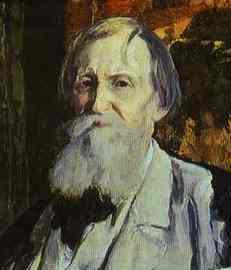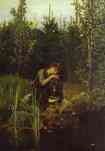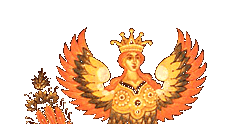 Victor Vasnetsov
(1848-1926)
Son of a village clergyman, Victor Mikhailovich Vasnetsov prepared himself for the same career, but the passionate love for art brought the 19-year-old student of ecclesiastical seminary to St. Petersburg's Academy of Arts. During his years (1868-75) in the Academy Vasnetsov got a thorough professional training; especially big role in his education played professor Pavel Tchistyakov.
Victor Vasnetsov started as a scene painter; the influence of Fedotov and Perov in his early works is evident Moving House (1876), At a Bookseller's (1876), News from the Front (1878), A Game of Preference (1879). In late 1870s, early 1880s Vasnetsov tried himself in historical genre Battle of Slavs and Scythians (1881), After Prince Igor's Battle with the Polovtsy (1880). He borrowed the subjects from old history. Another resource for themes he found in Russian mythology - legends, ballads, fairy-tales. Vasnetsov was born and grew up in a northern Russian village and almost to the age of 20 lived in an environment where the 'folklore outlook' was still alive; his very soul was steeped in the poetry of Russian epic literature. He was not only the one of the first artists to turn to the subjects in folklore, but also the first to look for methods and device in national folk art. Thus he became the founder of new style in Russian painting.
Vasnetsov was an active member of the Abramtsevo circle (Abramtsevo, the estate of the well-known patron of the arts, Savva Mamontov), which sought to revive national traditions. Many undertakings by the Abramtsevo Colony, whether the construction of a church at Abramtsevo, where Vasnetsov, as the designer, first coped with the problem of creating a whole, integral ensemble, or the erection of the 'Witch's Hut" (also to his design), or the sets and costumes for the production of Alexander Ostrovsky's lyrical fairy-tale The Snow Maiden and for Nikolai Rimsky-Korsakov's opera of the same name, staged at Mamontov's private Opera in 1885, were to become milestones not only for Vasnetsov but also for the Russian art in whole.
In 1882 Vasnetsov received a commission to produce a decorative panel for the rotunda of the Historical Museum in Moscow, that was his first big monumental project. Yet, the most significant and time-consuming work of this type was the decoration of the Cathedral of St. Vladimir in Kiev, which Vasnetsov began in the autumn of 1885 on the invitation of the art historian Adrian Prakhov, who supervised the construction of the cathedral. Vasnetsov jumped at this offer as it gave him the opportunity to create an integral ensemble comparable to those done by ancient fresco-painters. Work on the decoration of the cathedral took over 10 years, during which Vasnetsov executed nearly 400 sketches and studies. The murals he painted with his assistants covered almost two thousand square meters. Fulfilling this assignment Vasnetsov relied on his favorite range of motifs and characters, painting the walls with the images of princes Vladimir, Alexander Nevsky, Andrey Bogoliubsky, Princess Olga, the chronicler Nestor, and other outstanding figures from Russian history.
In the late 19th and early 20th centuries Vasnetsov actively worked in different fields. He produced a number of architectural designs, including those for his own house in Moscow (1894), for a pavilion at the World's Fair in Paris (1898), and for E. Tsvetkov's house on the Moskva River (1901-03), as well as designs for decoration of the Great Kremlin Palace (1898), the Faceted Chamber (1901-03), and other buildings in Moscow Kremlin. In 1904 he designed the façade of the Tretyakov Gallery.
During the last 20 years of his life Vasnetsov turned to his favorite lyrical subjects inspired by Russian fairy-tales. These include Three Bogatyrs (1898), The Frog Tsarevna (1918), The Tale of the Sleeping Beauty (1900-26), and the Unsmiling Tsarevna (1916-26). Thanks to his enchantment with Russian epos and history, thanks to his search for a genuinely Russian pictorial idiom, Vasnetsov was able, of the eve of the 20th century, to inspire many artists to reaffirm the moral and aesthetic ideals of the people, to revive Russian's spiritual legacy.
His painting influenced greatly the development of modernism and symbolism in Russian painting and poetry. Victor Vasnetsov
(1848-1926)
Son of a village clergyman, Victor Mikhailovich Vasnetsov prepared himself for the same career, but the passionate love for art brought the 19-year-old student of ecclesiastical seminary to St. Petersburg's Academy of Arts. During his years (1868-75) in the Academy Vasnetsov got a thorough professional training; especially big role in his education played professor Pavel Tchistyakov.
Victor Vasnetsov started as a scene painter; the influence of Fedotov and Perov in his early works is evident Moving House (1876), At a Bookseller's (1876), News from the Front (1878), A Game of Preference (1879). In late 1870s, early 1880s Vasnetsov tried himself in historical genre Battle of Slavs and Scythians (1881), After Prince Igor's Battle with the Polovtsy (1880). He borrowed the subjects from old history. Another resource for themes he found in Russian mythology - legends, ballads, fairy-tales. Vasnetsov was born and grew up in a northern Russian village and almost to the age of 20 lived in an environment where the 'folklore outlook' was still alive; his very soul was steeped in the poetry of Russian epic literature. He was not only the one of the first artists to turn to the subjects in folklore, but also the first to look for methods and device in national folk art. Thus he became the founder of new style in Russian painting.
Vasnetsov was an active member of the Abramtsevo circle (Abramtsevo, the estate of the well-known patron of the arts, Savva Mamontov), which sought to revive national traditions. Many undertakings by the Abramtsevo Colony, whether the construction of a church at Abramtsevo, where Vasnetsov, as the designer, first coped with the problem of creating a whole, integral ensemble, or the erection of the 'Witch's Hut" (also to his design), or the sets and costumes for the production of Alexander Ostrovsky's lyrical fairy-tale The Snow Maiden and for Nikolai Rimsky-Korsakov's opera of the same name, staged at Mamontov's private Opera in 1885, were to become milestones not only for Vasnetsov but also for the Russian art in whole.
In 1882 Vasnetsov received a commission to produce a decorative panel for the rotunda of the Historical Museum in Moscow, that was his first big monumental project. Yet, the most significant and time-consuming work of this type was the decoration of the Cathedral of St. Vladimir in Kiev, which Vasnetsov began in the autumn of 1885 on the invitation of the art historian Adrian Prakhov, who supervised the construction of the cathedral. Vasnetsov jumped at this offer as it gave him the opportunity to create an integral ensemble comparable to those done by ancient fresco-painters. Work on the decoration of the cathedral took over 10 years, during which Vasnetsov executed nearly 400 sketches and studies. The murals he painted with his assistants covered almost two thousand square meters. Fulfilling this assignment Vasnetsov relied on his favorite range of motifs and characters, painting the walls with the images of princes Vladimir, Alexander Nevsky, Andrey Bogoliubsky, Princess Olga, the chronicler Nestor, and other outstanding figures from Russian history.
In the late 19th and early 20th centuries Vasnetsov actively worked in different fields. He produced a number of architectural designs, including those for his own house in Moscow (1894), for a pavilion at the World's Fair in Paris (1898), and for E. Tsvetkov's house on the Moskva River (1901-03), as well as designs for decoration of the Great Kremlin Palace (1898), the Faceted Chamber (1901-03), and other buildings in Moscow Kremlin. In 1904 he designed the façade of the Tretyakov Gallery.
During the last 20 years of his life Vasnetsov turned to his favorite lyrical subjects inspired by Russian fairy-tales. These include Three Bogatyrs (1898), The Frog Tsarevna (1918), The Tale of the Sleeping Beauty (1900-26), and the Unsmiling Tsarevna (1916-26). Thanks to his enchantment with Russian epos and history, thanks to his search for a genuinely Russian pictorial idiom, Vasnetsov was able, of the eve of the 20th century, to inspire many artists to reaffirm the moral and aesthetic ideals of the people, to revive Russian's spiritual legacy.
His painting influenced greatly the development of modernism and symbolism in Russian painting and poetry.
Notes
A Knight at Crossroads. In many Russian folk-tales there is such an episode when a traveling vityaz (knight) at the crossroads meets a rock with not very much inspiring choice:
If you go to the right - you'll loose your horse;
If you go to the left - you'll loose your life;
If you go right ahead - you'll loose both�
After Prince Igor's Battle with Polovtsy. The subject is from Russian history, a military campaign of Prince Igor Svyatoslavovich, Prince of Seversk, against southern neighbors of Russia - Polovtsy. The small military campaign, there were many of such between Russia and its south neighbors, remained immortalized thanks to the poem by the unknown bayan (poet). The poem, which survived till our days and is considered to be the oldest literary work in Russian, accused the quarrels among the Russian princes, their military adventures, which brought only grief to Russians. The theme was the subject of the opera by Alexander Borodin Prince Igor.
St. Vladimir, Prince Vladimir Svyatoslavovich (960-1015), the Great Duke of Kiev (980-1015), the youngest son of Great Duke Svyatoslav, the grandson of Princess Olga. He came to power after bloody intrigues against his elder brothers. In 988 he asked for the hand of the Byzantine princess Anna. Byzantine rulers, wishing to have him as an ally, agreed, but their condition was that Vladimir was to accept Christianity. He was baptized himself and adopted Christianity as official religion of Russia.
Princess Olga ( ?- 969), the Great Duchess of Kiev (945-969), she was the wife of Great Duke Igor, son of Ruric. Igor was killed by the rebelled subjects, when his son Svyatoslav was small, and decisive Olga started to rule herself. First he avenged her husband's killers: she came to their town with troops but did not attack the town, just asked the citizens to pay her tribute: a dove and a sparrow from every house. The happy residents hurried to bring her the demanded tribute. After that Olga's soldiers tied hemp to birds' feet and put fire on it. The birds returned to their homes under the roofs and put the town on fire. Olga consolidated the state, subordinated Novgorod. When her son could rule the state himself she went to Constantinople, where she was baptized, her godfather was the Byzantine Emperor. Olga tried to persuade her son Svyatoslav to accept Christianity, but in vain. She succeeded though with her grandson Vladimir.
Prince Andrey Bogolyubsky (1111-1174), Great Duke of Vladimir (1169-1174), son of Yuri Dolgoruky. When he became the Great Duke he transferred the capital of Russia from Kiev to Vladimir. Tatyana Anatolyevna Mamontova (1864-1920), daughter of Anatoliy Ivanovich Mamontov, publisher, owner of the publishing house and a bookstore in Moscow, nephew of Savva Ivanovich Mamontov. See also her portrait by I. Repin.
The Bard Bayan, a poet in old Russia, who presented his verses in the form of songs, ballads, accompanying himself on a dulcimer.
Ivan Tsarevich Riding the Grey Wolf is a Russian folk-tale about adventures of prince and his companion gray Wolf (who knew some magic). Tsarevich saved Wolf's cubs and Wolf helped him in several quests: to get golden apples, to get a horse with golden mane, and to get a beautiful princess.
The Frog Tsarevna is a Russian folk-tale. Three sons of the tzar, wishing to find wives shoot arrows in different directions: the first son's arrow fell in the yard of a nobleman, he married the nobleman's daughter; the second son's arrow fell on a merchant's yard, he married the merchant's daughter; the third son's arrow flew away to the swamps and was picked up by a frog. Of course it was an enchanted princess. After many dangerous adventures and a series of quests the youngest prince managed to make her a girl again.
The Snow Maiden is a Russian folk-tale about a girl, daughter of the Frost (father) and Spring (mother), made of snow. She lived safely among people as an adopted daughter of an old and childless couple. She was beautiful and every man fell in love with her but not for long, because she could not love back. All the suitors, one by one, left her for her not beautiful but lively friends. The Snow Maiden envied them and asked her mother, Spring, to give her ability to love. Love was fatal for her. She fell in love and was melted by the Sun. The tale was the subject of the play by Alexander Ostrovsky and opera by Nikolay Rimsky-Korsakov. Vasnetsov painted the sketches of costumes for the opera.
Three Bogatyrs, or three knights, are the heroes of legends: Ilya Muromets, Dobrynya Nikitich and Aliosha Popovich. Each of the character has his own set of legends. Though every hero had his own adventures, every one defended his land, the poor, and fought enemies of Russia; and they were all adored by people. Here the painter depicted them all together, guarding Russian boarders.
Unsmiling Tsarevna is a Russian folk-tale about a sad heiress of a tzar, who promised to give her and his throne to a person, who could make the tsarevna laugh.
Alyonushka is a Russian folktale about orphan sister and brother, Alionushka and Ivanushka. Their father remarried and the stepmother appeared to be a witch, who wanted by various means to get rid of the children.
The Magic Carpet, on which one could fly, is an element of many Russian folk-tales, probably borrowed from the orient tales.
Vera Savvishna Mamontova (1875-1907), daughter of Savva I. Mamontov, married to Samarin. See also her portrait by Serov.
Mark Antokolsky (1843-1902) is an outstanding Russian sculptor of Jewish origin, studied in St. Petersburg Academy of Arts (1862-68). Because of poor health lived mostly in Italy, visiting Russia from time to time. Executed commissions for Russian cities, e.g. Monuments to Peter I in Archangelsk and in Taganrog.
Chronicler Nestor (the second half of XI - the first half of the XII centuries) was a monk of the Kiev-Pechersk Lavra (Abbey), author and chronicler. He described the life and martyrdom of the first Russian saints Boric and Gleb, Feodosiy Pechersky. He is considered to be the author of the first known Russian chronicles.
Painter Alipiy (? - 1114) executed the mosaics of the Uspensky Catthedral in Kiev-Pechersk Lavra (Abbey).
 Alyonushka. 1881. Oil on canvas. The Tretyakov Gallery, Moscow, Russia.
Alyonushka. 1881. Oil on canvas. The Tretyakov Gallery, Moscow, Russia.
|



